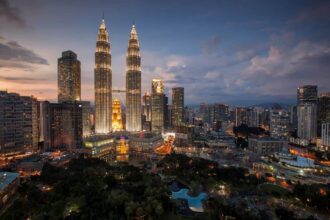Travel vlogging has grown from casual clips into a creative form of storytelling that blends personality, visual craft, and cultural connection. What began as quick snapshots of trips has matured into a space where travellers build communities, inspire exploration, and share experiences in real time.
In fact, the global market value for travel blogging/vlogging is estimated at USD 4.5 billion in 2025, with a projected growth rate of 12% annually, indicating how it’s gaining serious economic value.
Viewers now expect stories with meaning, authenticity, and a sense of discovery. For small creators, freelancers, and aspiring entrepreneurs, travel vlogging is a viable way to build a personal brand, grow a following, and even generate income through content partnerships or ad revenue.
However, doing it well takes more than a camera and a ticket. This guide explores eight essential tips to help you shape your vlogging process, from planning to publishing stories that connect with viewers and stand out in a crowded space.
How to create unforgettable travel vlogs
Heading off on an international trip to see the Northern Lights? Or maybe exploring the US national parks using Indie Campers’ RV hire in Seattle? The best kind of travel vlogging requires more than just capturing beautiful scenery. It’s about telling a story that connects with your audience and reflects your unique perspective.
1. Define your vlogging style
Every successful travel vlogger has a clear identity. Before filming, decide what you want your videos to represent. Think about your tone, pacing, and the kind of places or stories that interest you most.
There’s no harm in learning from other creators, but use that research to clarify your own direction rather than mimic theirs. Understand how they use colour, sound, and transitions. Notice how they interact with the camera.
Consistency helps audiences recognise your work, so keep your visual and narrative approach aligned across videos. Use a similar palette, logo, and tone of voice. Over time, your style will evolve naturally, but viewers should always be able to tell it’s you. The goal is to build a personal signature.
2. Create a filming plan
Behind every effortless-looking travel vlog is a bit of planning. Start by listing key scenes, locations, and moments you want to capture, and think about how each shot fits your story.
- Scout locations: Check lighting, angles, and accessibility. Even a quick walk around can reveal the best spots.
- Time your shots: Early mornings and late afternoons offer the most flattering light.
- Plan logistics: Make sure you can carry, charge, and store your equipment efficiently.
- Stay flexible: Some of the best footage comes from unplanned moments — leave room for spontaneity.
- Map your narrative: Sketch a rough sequence so you know the story flow before editing.
3. Prepare your equipment
Preparation saves time later. Test every camera, mic, and accessory before you leave. Record short clips to check audio levels, focus, and stabilisation. Carry spares for key items such as batteries, memory cards, and cables in case of sudden failures.
Keep your setup light enough to move quickly but complete enough to handle unexpected conditions. A simple packing system helps: one bag for main gear, one for accessories, and one for editing tools. Think about how you’ll manage power and data backups on the road. A portable SSD or cloud backup service can protect your footage if something goes wrong.
If you plan for editing, you’ll save hours later. A YouTube transcript generator can help you outline voiceovers, prepare captions, and build SEO-friendly scripts while you’re still travelling. Tools like Happyscribe make this process even easier by automatically generating accurate transcripts and subtitles, giving you a clear foundation for narration and editing.
These habits form efficient systems for managing complex creative workloads in demanding travel environments, a mindset that separates casual vloggers from professionals.
4. Choose the right gear
Your equipment should fit your filming style and travel pace. Think about the kind of content you want to create and the environments you’ll be filming in.
- Camera Equipment: A compact camera with reliable stabilisation and good low-light performance is ideal. Mirrorless systems balance quality and portability.
- Stabilisation Tools: Use a gimbal or lightweight tripod for steady footage. Handheld shots can work too if they fit your story’s tone.
- Audio Equipment: Invest in a small shotgun or lapel microphone. Viewers connect more with clear sound than perfect visuals.
- Accessories: Keep enough batteries, memory cards, and cleaning tools. Lightweight, multi-use accessories save space and reduce setup time.
5. Refine your filming techniques
Composition and movement shape how people experience your video. Use the rule of thirds to balance your framing and create depth with leading lines or layers. Smooth movement adds professionalism, but small imperfections can make your footage even more realistic.
Movement and dynamism
Combine steady tracking shots with natural, candid moments. A slow pan across a mountain range can be followed by a quick handheld laugh with a local vendor.
Lighting considerations
Natural light is your strongest ally. Film during golden hour when possible, but don’t shy away from changing weather. Overcast skies or shifting light can add character if handled well.
Shot checklist
Capture a range of wide, medium, and close-up shots. Film transitions and detail shots like signs, meals, and footsteps help tell the story without words. These smaller visuals make your vlog richer and easier to edit.
6. Strengthen your storytelling
While good visuals draw attention, good stories hold it. A travel vlog works best when it feels like a journey with a clear beginning, middle, and end.
Start with a hook, maybe a question, a moment of discovery, or a scene that sets the mood, then follow it with an emotional rhythm that combines action with reflection. Viewers want to see what happens, but they also want to know what it means to you.
Use both narration and on-camera moments to connect with your audience. Include local perspectives or short interviews where appropriate. Look for visual patterns that can reappear across episodes, like a recurring shot or sound cue. These small touches help create continuity and strengthen your brand identity.
Think about colour and tone as emotional tools: warmer palettes for energy and comfort, cooler tones for distance or calm.
7. Master your sound
Sound is often what separates an amateur video from a professional one. Record narrations clearly and avoid background noise by using a directional microphone. Capture natural audio wherever you can, such as that coming from footsteps, city sounds, wind, or local music. These small details make each place feel alive.
Choose tracks that fit the pace and atmosphere of your story. Always check copyright permissions or use royalty-free music to protect monetisation. Blend your music and ambient sounds so they support each other. Occasional silence can also add impact, giving the audience a moment to take in what they’re seeing.
8. Edit and share with intention
We’re almost there. Editing shapes the story and sets the tone. You can start by organising your files and keeping backups. Ensure you note which clips capture the best light, sound, or emotion.
Edit pacing to reflect your destination. Fast cuts resonate well with city scenes, while slower transitions suit landscapes or reflective moments. Colour grading adds polish, but keep it subtle so the footage looks natural.
Once your vlog is live, your work isn’t quite done. Tracking performance data in real time helps you understand what truly resonates with viewers. Just as real-time data gives businesses a competitive edge, it can help creators fine-tune future videos, identify what connects emotionally, and improve storytelling with each upload.
How to build audience engagement and grow your travel Vlog channel
Publishing your vlog is only half the work; engagement keeps it alive. Building a devoted audience today is about forming genuine connections with viewers who share your curiosity and values. Every comment, like, and share is part of a bigger conversation that can shape how your channel evolves.
Think of engagement as a two-way street. When you reply to feedback, ask questions, or share behind-the-scenes moments, you turn casual viewers into invested followers. Over time, those interactions build trust and recognition, which are essential for growth.
In fact, as digital audiences become more conscious about how their information is used, creators who value transparency will stand out, emphasizing why privacy should be every marketer’s next competitive edge.
Consistent engagement also signals to platforms like YouTube and TikTok that your content is active and worth recommending, helping you reach even more people organically. Treat every upload as an opportunity to refine your communication style, test new ideas, and strengthen your relationship with your audience.
The journey of a great travel vlogger
Great travel vlogs come down to a mix of planning, honesty, and curiosity. Focus on telling a story rather than just showing where you’ve been. Every trip teaches you something new and gives you a chance to get better at your craft.
Keep filming, keep learning, and share what you discover along the way. In the end, it’s your authenticity and steady creativity that make your videos truly stand out.


















